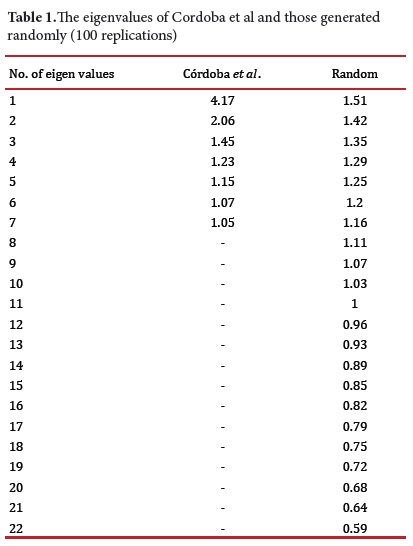Services on Demand
Journal
Article
Indicators
-
 Cited by SciELO
Cited by SciELO -
 Access statistics
Access statistics
Related links
-
 Cited by Google
Cited by Google -
 Similars in
SciELO
Similars in
SciELO -
 Similars in Google
Similars in Google
Share
Colombia Médica
On-line version ISSN 1657-9534
Colomb. Med. vol.44 no.4 Cali Oct./Dec. 2013
Letter to Editor
Parallel analysis and MBI-HSS: How many factors?
Mr. Editor: It has been only recently possible to validate the Maslach Burnout Inventory-Human Services Survey (MBI-HSS)1 among health professionals of Cali2, an important step for using this instrument with local empirical support in regard to its reliability of scoring and internal structure. However, two aspects of this analysis can be considered as methodological weaknesses. First, the Cronbach alpha coefficient was calculated for the total group of items, and this is absolutely inappropriate because: a)the authors did not demonstrate empirical support for accomplishing this (e.g., a hierarchical factor analysis), b) the literature indicates that factors in the MBI-HSS are generally independent, a characteristic also reported by Córdoba et al.2, and the same authors of the MBI-HSS1) the authors did not report the inter-factor correlations with which an appreciation could have been obtained, at least an heuristic one of the common degree of variance among the factors. Secondly, the authors obtained seven factors in their exploratory factor analysis; this large number of actors seems to be a product of applying a factor retention method that is now consensually seen as inaccurate and little recommended3,4. Specifically, it is known as Kaiser's rule, Guttman's rule or simply K14. The problem identified with this method is its over-estimation of the number of factors to be retained3,4, a situation that clearly occurs in the results reported by Cordoba et al.2, as reported in their Table 1.
A more accurate method which has gained a scientific consensus for good practices for retaining the number of factors is called parallel analysis3,4. This procedure is based on the work of Horn4, which consists of randomly creating the same number of variables as the number of items analyzed (in the case of MBI-HSS, 22 items),correlating them and extracting eigenvalues against which the eigenvalues derived from the empirical data under analysis are compared. This procedure was applied to the eigenvalues reported by Cordoba et al.2, in Table 2 by means of the Monte Carlo PCA5 program (100 replications). Our results are shown in Table 1.
The appropriate number of factors to retain is achieved by making a one to one comparisons of the eigenvalues, keeping the empirical eigenvalue that is less than the random eigenvalue. Conceptually, this indicates that the significant eigenvalues must be greater than those generated randomly. In Table 1, the number of eigenvalues to retain is 3, which is exactly the same number of factors underlying the MBI-HSS. Validating the result with a conceptual analysis of these three factors, would leave one to conclude that the factorial structure of the MBI-HSS is replicable in the sample studied. Compared with the first result of the authors (7 factors), the methodological difference is clear. Finally, we note that the use of parallel analysis should be recommended for making more accurate decisions about the number of factors to retain.
References
1. Maslach C, Jackson, S. Maslach Burnout Inventory-Human Services Survey (MBI-HSS). In: Maslach C, Jackson, S. Leiter M. editors. Maslach Burnout inventory manual. Mountain View: Consulting Pschologists Press; 1996. [ Links ]
2. Córdoba L, Tamayo J, González M, Martinez M, Rosales A, Barbato S. Adaptation and validation of the Maslach Burnout inventory-human services survey in Cali, Colombia. Colomb Med. 2011; 42(3): 286-93. [ Links ]
3. Hayton JC, Allen DG, Scarpello V. Factor retention decisions in exploratory factor analysis: A tutorial on parallel analysis. Organ Res Meth. 2004; 7(2): 191-205. [ Links ]
4. Dinno A. Exploring the sensitivity of Horn's parallel analysis to the distributional form of random data. Multivariate Behav Res. 2009; 44(3): 362-88. [ Links ]
5. Watkins MW. Monte Carlo PCA for parallel analysis [computer software]. State College, PA: Ed & Psych Associates. 2000. [ Links ]














